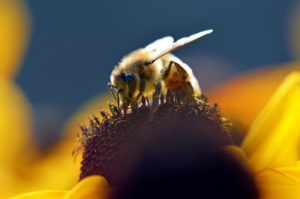Pesticide Industry Creating Misinformation Campaigns Against Bee-Protecting Legislation

Would it surprise you to hear that the pesticide industry is actively working to halt measures that would protect bees from dying in record numbers across the continent? A new report published by Friends of the Earth (FOE) this week lists the tactics the industry is using to get in the way of much needed federal and state legislation and, spoiler alert, there are a lot of them. Last month, the U.S. Department of Agriculture reported that 44 percent of honeybee colonies nationwide died off last year, marking a sharp increase in the destruction that has a devastating trickle-down effect on American food crops. Yet, the pesticide industry still works to block protective legislation and it’s all because they stand to make a profit on the death of our important pollinators.
For years, chemical researchers and entomologists have been building a case against pesticides, composed of overwhelming evidence that widespread use of the chemicals—primarily in agriculture but also in public parks and residential areas—threatens bee populations in a very real way. Without wild honeybees, the nation’s crops and food supplies are in danger, so many agencies at the federal and state level have considered programs to protect bees, ranging from pesticide bans to protected “honeybee corridors” to “pro-bee-iotics” that may protect the buzzing beauties from dangerous chemicals.
Related: 44 percent of U.S. honeybee colonies died off last year

The FOE report also claims the pesticide industry has “infiltrated federal regulatory agencies” through employees of the U.S. Department of Agriculture and the Environmental Protection Agency who previously worked for different regulatory agencies and companies including Bayer, Syngenta, andMonsanto, which all profit from pesticide use. FOE also charges the pesticide industry with creating misinformation campaigns against bee-protecting legislation, by “directly funded or influenced science by donating to education initiatives and building strategic alliances with academics.”
Despite the industry’s efforts, some states are making forward progress to protect bees. Earlier this spring, Maryland became the first state in the country to ban neonicotinoids, the class of pesticideswith strong links to the decline in bee populations. Other types of pesticides harm bees, too, which means reducing pesticide use or restricting certain varieties is only one part of the puzzle when it comes to protecting bee populations. Federal and state lawmakers must be free to evaluate their options without the tainted influence of the industry that seeks only to profit from the destruction of our delicate ecosystem.
Honeybees devastated by second highest bee die-off on record in 2014

According to the Bee Informed Partnership, in 2014 beekeepers across the United States reported the second highest number of losses ever recorded, signaling a serious threat to America’s food supply. Conducted in collaboration with the Apiary Inspectors of America and the United States Department of Agriculture, the study surveyed 14.5 percent of the 2.74 million managed bee colonies in the country and found that 42.1 percent of bees died between April 2014 and April 2015. Oklahoma reported the highest losses at 63.4 percent, while Hawaii posted the lowest number at 14 percent.
Escalating bee die-offs in recent years have been attributed to the excessive use of neonicotinoids, water-soluble pesticides that affect the ability of bees to forage for nectar and locate flowers. These pesticides may also affect bees’ ability to locate their hives. European countries have taken a strong stance against neonicotinoids, but the U.S. has been slower to act despite a Presidential Memorandum issued by President Obama in June 2014 aimed at establishing a federal strategy to assess the impact of these pesticides on bees and other pollinators.
Related: Stressed-out young bees contribute to colony collapse disorder
Tiffany Finck-Haynes, food futures campaigner with Friends of the Earth, said, “These dire honey bee numbers add to the consistent pattern of unsustainable bee losses in recent years that threatens our food system. The science is clear—we must take action now to protect these essential pollinators from bee-toxic pesticides.”
“Bayer, Syngenta and Monsanto make billions from bee-killing pesticide products while masquerading as champions of bee health,” Finck-Haynes said. “Are their profits more important than our food supply? Are they more important than the livelihoods of America’s farmers? The Obama administration must act now to restrict neonicotinoid pesticides that threaten America’s bees, farmers and food security.”
Source(s):
inhabitat.com
foe.com
beeinformed.org
ecowatch.com